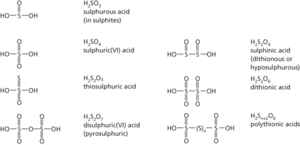A colourless oily liquid, H2SO4; r.d. 1.84; m.p. 10.36°C; b.p. 338°C. The pure acid is rarely used; it is commonly available as a 96–98% solution (m.p. 3.0°C). The compound also forms a range of hydrates: H2SO4.H2O (m.p. 8.62°C); H2SO4.2H2O (m.p. –38/39°C); H2SO4.6H2O (m.p. –54°C); H2SO4.8H2O (m.p. –62°C). Its full systematic name is tetraoxosulphuric(VI) acid.
Until the 1930s, sulphuric acid was manufactured by the lead-chamber process, but this has now been replaced by the contact process (catalytic oxidation of sulphur dioxide). More sulphuric acid is made in the UK than any other chemical product; production levels (UK) are commonly 12 000 to 13 000 tonnes per day. It is extensively used in industry, the main applications being fertilizers (32%), chemicals (16%), paints and pigments (15%), detergents (11%), and fibres (9%).
In concentrated sulphuric acid there is extensive hydrogen bonding and several competing equilibria, to give species such as H3O+, HSO4−, H3SO4+, and H2S2O7. Apart from being a powerful protonating agent (it protonates chlorides and nitrates producing hydrogen chloride and nitric acid), the compound is a moderately strong oxidizing agent. Thus, it will dissolve copper:
It is also a powerful dehydrating agent, capable of removing H2O from many organic compounds (as in the production of acid anhydrides). In dilute solution it is a strong dibasic acid forming two series of salts, the sulphates and the hydrogensulphates.

Sulphur acids
- KSLV
- k-space
- K star
- K/T boundary event
- Ku band
- Kubitschek, Juscelino (1902–76)
- Kublai Khan (1216–94)
- Kuder–Richardson formulae
- kudu
- Kuehneosaurus latus
- Kuenen, Philip Henry (1902–72)
- Kueyen
- Kuhn, Richard
- Kuhn, Thomas Samuel (1922–96)
- Kuiper Belt
- Kuiper belt
- Kuiper, Gerard Peter
- Kuiper, Gerard Peter (1905–73)
- Kuiperian
- Ku Klux Klan
- kulak
- Kula Plate
- Kullback, Solomon (1903–94)
- Kullback–Leibler information
- Kulldorff scan statistic